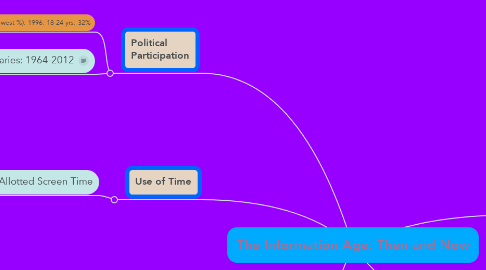
1. Media's role in providing information to citizens
1.1. Level of Censoring
1.1.1. THEN: Highly edited content
1.1.2. NOW: Raw, often unedited content
1.2. Frequency
1.2.1. THEN: Daily or weekly access to information
1.2.2. Now: Instantaneous
2. Economic changes that impact local employment
2.1. Place of Work
2.1.1. THEN: Go to workplace
2.1.2. NOW: Increased possibility of working from home
2.1.2.1. Telecommuting for work climbs to 37% (Gallop, 2015)
2.2. Place of Product Production
2.2.1. THEN: Local factories
2.2.2. NOW: Outsourcing
3. Political Participation
3.1. THEN (lowest %): 1996: 18-24 yrs: 32%
3.2. Voting Age Varies: 1964-2012
3.2.1. NOW (highest %): 2012: 18-24 yrs: 45%
3.2.2. Young Adult Voting: An Analysis of Presidential Elections from 1964-2012
4. Use of Time
4.1. View of Allotted Screen Time
4.1.1. THEN: Time spent in front of a screen, radio, etc. was limited/monitored
4.1.1.1. “For the past six decades, parents have limited their children’s time in front of the television. Why? Because they instinctively knew that kids who watch a lot of television don’t easily develop long-term concentration skills, and they, being responsible parents, wanted to do what was best for their children. And before the age of television, parents restricted time in front of the radio. And before the age of radio, books and movies were screened. Even Plato, way back in 380 BC, was critical of the stories, music, and plays that entranced so many in his day. In other words, people of every age—especially parents—have felt an ethical obligation to protect and guide children, and that meant managing the media of the day” (Lotti, 2015).
4.1.2. NOW: Increased normalization of screen time has led to lessened censorship or monitored time
5. Types of "Issues"
5.1. Same Ethical Issues Present (i.e. plagiarism)
5.1.1. THEN: Easier to plagiarize because it was harder to track because there were fewer tools available to screen for plagiarism, but at the same time, information wasn't as readily available.
5.1.1.1. This REALLY interesting infographic shows internet availability throughout history. The World Wide Web launched in 1993, with the private sector taking over in 1995. In 2010, still only 1/2 of rural households had internet access at home. This is evidence to the fact that internet hasn't always been readily available in people's homes.
5.1.2. NOW: Easier to identify/prove plagiarism with tools such as Grammarly, yet easier to plagiarize because information is easy to access on the Web.
5.1.2.1. "the number who believed that copying from the Web constitutes “serious cheating” is declining — to 29 percent on average in recent surveys from 34 percent earlier in the decade (Gabriel, 2010)."
5.1.2.2. "[Blum] contends that undergraduates are less interested in cultivating a unique and authentic identity — as their 1960s counterparts were — than in trying on many different personas, which the Web enables with social networking (Gabriel, 2010)."

